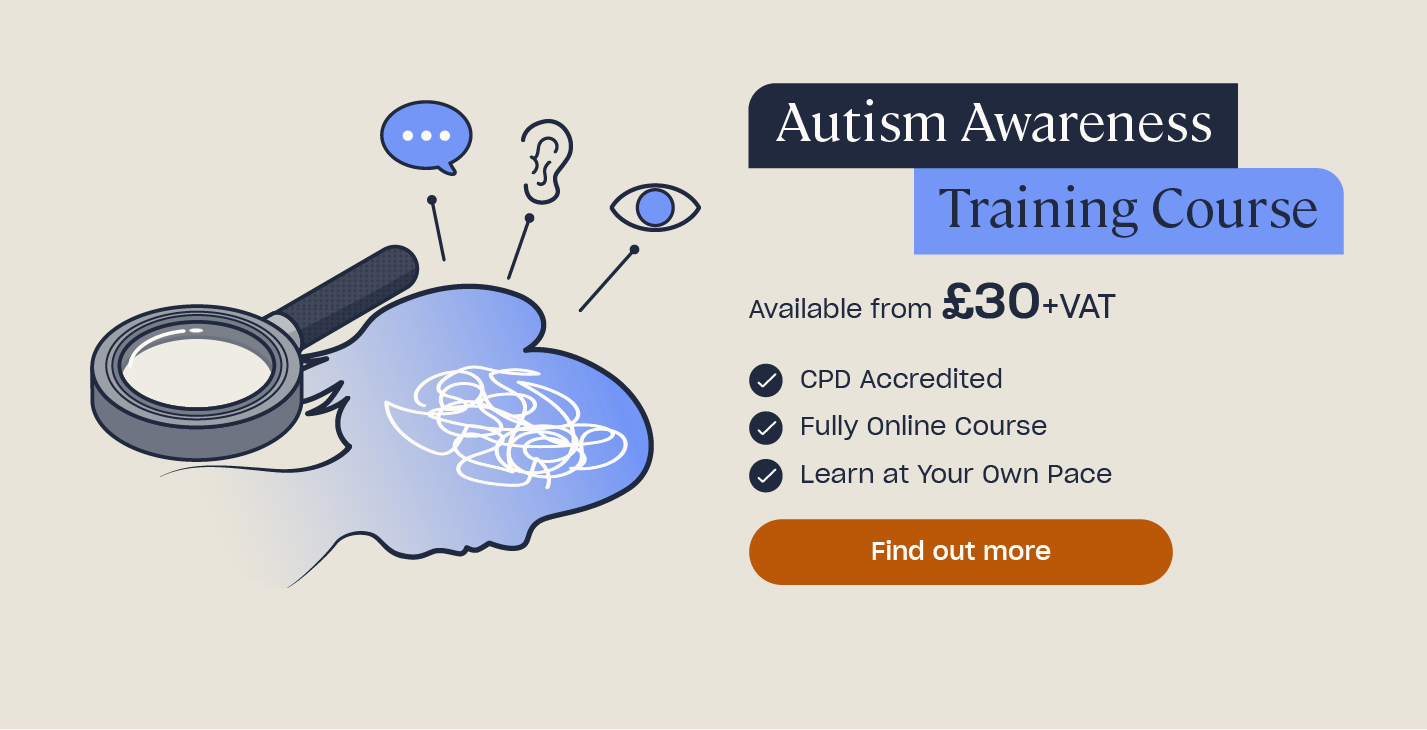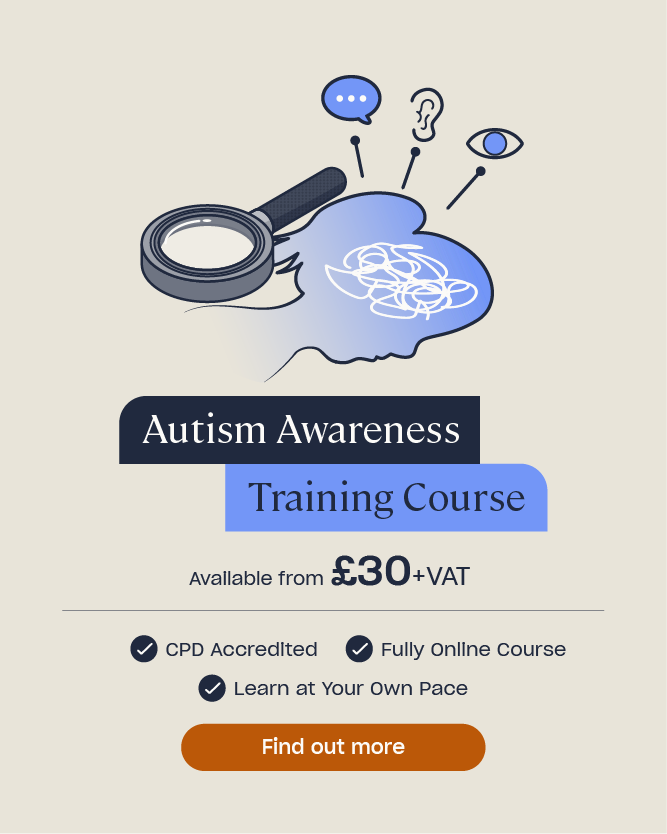Non-Verbal Communication in Autism
Autism is a lifelong neurodivergence and disability that impacts how an individual experiences the world. Autism is not a monolith and autistic people have a myriad of different strengths and difficulties from one another. Nevertheless, there are ‘core characteristics’ that a person must possess in order to receive an autism diagnosis. One ‘core characteristic’ is communication differences and autistic people often have different communication styles and preferences to non-autistic people. This also includes how autistic people communicate non-verbally.
It should be noted that non-verbal communication and ‘non-verbal autism’ are two separate things and should not be conflated or used interchangeably. Both autistic and non-autistic people use non-verbal communication, however it can manifest differently for autistic people. In this article we will explore some of the differences in how autistic people may use non-verbal communication.

What is Non-Verbal Communication in Autism?
Non-verbal communication refers to how people communicate with one another without speaking. It involves conveying meaning through a range of behaviours and signals such as:
- Body language
- Gestures
- Facial expressions
- Eye contact
- Tone of voice
Both autistic and non-autistic people use non-verbal communication and non-verbal communication in autism should not be conflated with ‘non-verbal autism.’ Non-verbal communication in autism refers to the different ways in which an autistic person may convey meaning using the behaviours and signals mentioned above. These signals may not appear to align with the discussion topic or may not match the way non-autistic people use non-verbal communication. However, that is not to say that autistic people do not use non-verbal communication to convey meaning.
Autistic people who are unable to speak, either temporarily or long term, are sometimes described as being ‘non-verbal.’ However, the National Autistic Society notes that some people with lived experiences do not prefer this term as it may be an inaccurate description of their experience or it may be misinterpreted to mean that they can’t communicate in any way irrespective of other means of communication such as writing, sign language or using Augmentative and Alternative Communication (AAC). It is therefore important to avoid blanket terms that may not accurately describe an individual’s experience.
Differences in Non-Verbal Communication
Everyone, regardless of whether they are autistic or not, communicates in different ways. Autistic people are not ‘different’ solely because of this, however in order for an autism diagnosis to be made these variances in communication must:
- Have been present since birth
- Have a clinically significant impact on a the person’s day to day life
Autism is not a monolith and the scale to which these communication differences impact an autistic person’s life can vary greatly. As mentioned above, some autistic people have speech differences or use alternative means to communicate which can greatly impact their ability to communicate with others. Comparatively, some autistic people may struggle to communicate but have learnt to mask the impact that it has on their day to day life, reducing the appearance of their difficulties but causing significant internal stress or anguish.
The language and words that we use to describe people are incredibly important. Many autistic people prefer to be referred to as being autistic rather than having autism. Autism is a lifelong neurodivergence and something that an individual is born with, not something that someone can develop or ‘catch.’ NHS England notes that this can be a sensitive issue as there isn’t one single term that is accepted by everyone and many autism organisations for children or young people use the term ‘with autism.’ Nevertheless, describing someone as ‘having’ autism is contested and becoming increasingly outdated.
The National Autistic Society notes that the theory of ‘double empathy’ can also explain the communication struggles that autistic people face. The theory, introduced by Dr Damian Mitlon, suggests that some communication issues between autistic and non-autistic people are not solely due to autistic cognition but also a breakdown in reciprocity and mutual understanding. This occurs when two people who experience the world differently struggle to empathise with one another. As such, having an understanding of how autistic people may communicate differently can help to bridge communication gaps by encouraging mutual empathy and understanding rather than a presupposition that an individual is communicating ‘poorly’ simply because they are autistic.

Understanding Non-Verbal Communication in Autism
As mentioned, both autistic and non-autitistic people use non-verbal communication to convey meaning. For non-autistic people, non-verbal communication may appear intuitive and provide valuable context that enhances a situation. For example, maintaining eye contact whilst speaking can be seen as a sign of confidence and surety in what is being said. However, for autistic people non-verbal communication may not ‘match’ the situation or present as expected. This can inadvertently lead to an autistic person being deemed rude or timid. For example, many autistic people struggle with eye contact and maintaining it during a conversation can be incredibly uncomfortable. Without an understanding that this is a common difference for autistic people it can easily be interpreted as timidity or even as a sign of dishonesty. As such, having an awareness of how non-verbal communication can present differently for autistic people can help to bridge the double empathy gap and allow for a more neutral interpretation of this communication.
The National Autistic Society notes that support strategies often expect autistic people to do the work to bridge the gap in communication styles and preferences between them and non-autistic people. These strategies often focus on training autistic people to act more like non-autistic people by masking their autistic characteristics. However, this is mentally exhausting and can cause significant stress and anxiety. Therefore, learning how communication styles can differ for autistic people reduces this pressure and shares the responsibility for bridging any gaps in communication.
Need a Course?
Our Autism Awareness Training Course is suitable for anyone whose job role requires them to work with autistic children, whether it’s on a full-time, part-time or voluntary basis. It will help you understand more about Autism Spectrum Disorders (ASDs) and how these affect the children that you work with.
Below you will find a brief overview of some of the differences in how autistic people communicate non-verbally. The list is by no means exhaustive and should not be viewed in a prescriptive manner, however it highlights how non-verbal communication that some may deem universal or easily understandable, can carry a very different meaning or pose unexpected challenges for autistic people.
Differences in non-verbal communication include:
- Body language and gestures – Autistic individuals can struggle to recognise or read body language in others. For example, it’s often thought that an upright posture suggests openness and confidence. However, an autistic individual may not interpret it in this manner in others and therefore not rely on this posture to convey openness in themselves. Moreover, they may use fewer gestures when talking which can be interpreted as a lack of engagement. Research suggests that autistic children are likely to use fewer gestures whereas autistic adults are likely to use them more which one could argue is the result of frequent misunderstanding and the hope that using gestures will make an autistic person ‘more understandable’ for others.
- Facial expressions – Many autistic people struggle to read facial expressions and to interpret the emotions that they are trying to convey. This may result in them responding ‘incorrectly’ and appearing insensitive to someone’s emotions or not picking up on hints or social cues. Furthermore, research suggests that autistic people display facial expressions less frequently than non-autistic people. This can result in a ‘mismatch’ between what an autistic individual says and what their face seems to express and can therefore be interpreted as aloofness or disinterest.
- Eye contact – Autistic people can find making eye contact incredibly uncomfortable. Research suggests that this is because it causes sensory and cognitive processing difficulties which can exacerbate pre-existing social communication challenges. This can make eye contact overwhelming for autistic people and a distraction that requires a lot of mental energy, making it harder for them to focus on the conversation at hand. As such, an autistic person may often avoid eye contact so that they can better focus on what is being said and how they want to respond. A lack of eye contact is often seen as rude or indicative of a lack of confidence. However, it should not be assumed that an autistic individual avoiding eye contact is doing so for these reasons. Comparatively, pressure to mask one’s autistic traits can lead an autistic person to make very intense eye contact. They may struggle to gauge how much eye contact is ‘appropriate’ or that the intensity of their eye contact is making someone uncomfortable.
- Tone of voice – Tone of voice can heavily influence the meaning of a conversation and how it is interpreted by others. However, tone of voice can vary greatly for autistic people and often does not seem to ‘match’ the conversation topic. A core characteristic of the social interaction and communication differences that autistic people have include speaking in an unusual accent, fluctuating rates of speech in terms of speaking quickly or slowly and intonation. Autistic people may also struggle to understand any ‘hidden’ meaning that is being conveyed via tone of voice and instead focus on what is being said rather than how it is being said. This can lead to social cues being missed or responses being deemed insensitive or inappropriate.
Understanding the different ways in which someone communicates non-verbally can help to make communication more accessible for all and avoid assumptions being made as to someone’s intention. Whilst many autistic people mask in order to communicate in a more socially acceptable manner, this is mentally taxing and the onus should not be solely on them to camouflage their differences in order to be understood. Taking the time to understand the communication challenges that autistic people face facilitates an empathetic approach which in turn can help autistic people to feel more comfortable and open when communicating.
Further Resources:
- What is Neurodiversity & How Does it Relate to Autism?
- Sensory Overload in Adults
- Non-Verbal Communication in Health and Social Care
- What is Autistic Masking?











